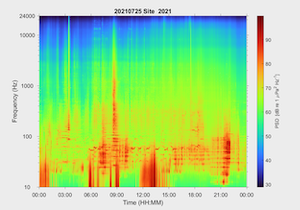SanctSound Hybrid Millidecade Spectra
To understand natural and anthropogenic sound in the ocean, and to compare underwater
soundscapes globally, standard methods of analysis must be applied to passive acoustic
monitoring (PAM) data. Methods that balance constrained volume and adequate resolution
of acoustic spectra have recently been published (Martin et al., 2021a,b). A community
effort supported by NOAA, BOEM, U.S. Navy, and ONR was initiated to apply these methods
to PAM datasets from around the world. These data are hybrid millidecade (HMD) spectra
of sound levels derived from calibrated passive acoustic data. Daily HMD at 1 minute
resolution were created using standalone MANTA software (v9.6.13) from audio data
recorded by the SanctSound monitoring project at various sites.
- Cite as: NOAA Office of National Marine Sanctuaries and U.S Navy. 2023. Hybrid Millidecade Spectra at 1 Minute Resolution Recorded for the Sanctuary Soundscape Monitoring Project (SanctSound). NOAA National Centers for Environmental Information. https://doi.org/10.25921/ymf8-5k59. [access date]
- 10.25921/ymf8-5k59
- NCEI Metadata ID:gov.noaa.ncei.pad:SanctSound_HMD
gov.noaa.ncei.pad:SanctSound_HMD
| Search Data |
|
| Download Data |
|
| Distribution Formats |
|
| Ordering Instructions | Contact NCEI for other distribution options and instructions. |
| Distributor | NOAA National Centers for Environmental Information ncei.info@noaa.gov |
| Dataset Point of Contact | Passive Acoustic Data Manager Passive Acoustic Data Manager DOC/NOAA/NESDIS/NCEI > National Centers for Environmental Information, NESDIS, NOAA, U.S. Department of Commerce pad.info@noaa.gov |
| Dataset Point of Contact | NOAA National Centers for Environmental Information ncei.info@noaa.gov |
| Time Period | 2021-01-26T20:00:00 to 2021-03-21T18:20:00 |
| Spatial Bounding Box Coordinates |
West:-180.0
East:-180.0
South:-90.0
North:90.0
|
| Spatial Coverage Map | |
| General Documentation |
|
| Publication Dates |
|
| Dataset Progress Status | Ongoing - data is continually being updated |
| Data Update Frequency | As needed |
| Purpose | Purpose statement not available |
| Dataset Citation |
|
| Principal Investigators |
|
| Publishers |
|
| Acknowledgments |
|
| Theme keywords | Global Change Master Directory (GCMD) Science Keywords
|
| Data Center keywords | Global Change Master Directory (GCMD) Data Center Keywords
|
| Platform keywords | Global Change Master Directory (GCMD) Platform Keywords
|
| Instrument keywords | Global Change Master Directory (GCMD) Instrument Keywords
|
| Place keywords | Global Change Master Directory (GCMD) Location Keywords
|
| Use Constraints |
|
| Access Constraints |
|
| Other Constraints | Cite as: NOAA Office of National Marine Sanctuaries and U.S Navy. 2023. Hybrid Millidecade Spectra at 1 Minute Resolution Recorded for the Sanctuary Soundscape Monitoring Project (SanctSound). NOAA National Centers for Environmental Information. https://doi.org/10.25921/ymf8-5k59. [access date] |
| Fees |
|
| Processing Steps |
|
| Instrument |
|
| Platform |
|
Last Modified: 2023-10-20
For questions about the information on this page, please email:ncei.info@noaa.gov
